How to Cite | Publication History | PlumX Article Matrix
Zodape G. V.
Departments of Zoology, S. S. and L.S. Patkar College of Arts and Science and V. P. Varde College of Commerce and Economics, S.V. Road, Goregaon (West), Mumbai- 400 062, India.
Corresponding Author E-mail: gautamvz5@yahoo.com
DOI : http://dx.doi.org/10.13005/bbra/2489
ABSTRACT: In case of Sitopbilus oryzae, Periplaneta americana and Gumbusia affinis (girard), 100 % mortality was noted after 24 hours of exposure to the crude extracts and the isolated compounds where as in control group 100% survival was noted. In the initial stage of the experiment on Sitopbilus oryzae, after 30 minutes of exposure, schooling behavior was observed. After 30 minutes the weevils were dispersed there after towards the corners of the petridishes. After 1hour the locomotary movement of the weevils was restricted and these weevils could not be moved afterwards. The Periplaneta americana showed cleaning behavior at the initial stages of poisoning by rubbing their bodies with their legs or sides of the cages. At the later stages of poisoning Periplaneta americana shows incoordination and convulsion leading to paralysis. Gumbusia affinis showed hypersensitivity, an increased respiratory rate by indicating rapid operculum movement. The fishes were become restless and the movement of the body and operculum of fishes becomes lower down and the fishes were settled down at the bottom of the aquarium. At the final stages of intoxication after 24 hours the fishes were dead and found floating on the surface of the aquarium. The area of the brain of dead fishes was found red in color. From the above symptoms it was evident that the toxin found in the crud extract and the isolated compounds of Tetraodon fluviatilis may contains strong toxin.
KEYWORDS: fluviatilis Sitopbilus Gumbusia; Tetraodon;
Download this article as:| Copy the following to cite this article: Zodape G. V. Studies on the Pesticidal Activities of Bioactive Compounds of Fish Tetraodon Fluviatilis of West Coast of Mumbai. Biosci Biotech Res Asia 2017;14(2). |
| Copy the following to cite this URL: Zodape G. V. Studies on the Pesticidal Activities of Bioactive Compounds of Fish Tetraodon Fluviatilis of West Coast of Mumbai. Biosci Biotech Res Asia 2017;14(2). Available from: https://www.biotech-asia.org/?p=25887 |
Introduction
New trends of science is marine bioorganic chemistry & its practical branch marine biotechnology is progressing promptly in recent years; a general goal of the discipline is to obtain different valuable substances by using biological processes in living marine organisms. The marine environment is an exceptional reservoir of bioactive natural products, many of which exhibit structural / chemical features that are not found in terrestrial natural products.1 Marine organisms have evolved biochemical and physiological mechanisms that include the production of bioactive compounds for such purposes as reproduction, communication, and protection against predation, infection and competition.2 Because of the physical and chemical conditions in the marine environment, almost every class of marine organism exhibits a variety of molecules with unique structural features.
Modern technologies have opened vast areas of research for the extraction of biomedical compounds from ocean & seas, because of high percentage of biomedical compounds exhibit substantial pharmacological activity. During the last 30 years, the field of marine natural product chemistry has provided to be a prolific source of novel biologically active compounds. In recent years, collaboration between chemists, biochemists & pharmacologists have seen the emergence of bioassay directed fractionation strategies as the most common route to the discovery of novel marine metabolites.
India has total length of the coastline is around 8014 Km which includes coastline of two groups of oceanic islands namely Andaman and Nicobar and Lakshadweep. India possess a vast Exclusive Economic Zone of 20,13,410 Sq. Km and territorial waters of 1,55889 Sq Km. The Indian coast has a variety of sensitive ecosystem like lagoons, sand dunes, coral reefs, mangroves, sea grass beds and wetlands.3 Mumbai, the island city is situated on west coast of India (between 18051’ to 19033’ N and long 72043’ 73001’ E). Arabian Sea enriches the Mumbai with a shore line of 100 Km, coastal areas in and around Mumbai are biologically most productive areas supporting a wealth of marine resources.
The Indian sub‑continent offers potential for pursuing marine biotechnology research for discovering novel biologically active compounds that could be used in a large spectrum of human ailments and harvest bio resources for sustainable development with this context. Indian labs have concentrated on bioactive substances from marine animals such as horseshoe crab, green mussels, sponges and corals for characterization of novel molecules. The Department of Biotechnology (DBT) has been promoting marine biotechnology in India for the last one and half decade. Many R&D programs sponsored on marine biotechnology are leading towards products and process developments and development of a viable technology for the commercial production systems. The work carried out by NIO4 and others consist of bioactivity of the compounds collected from the coast of south and south – east India. Some work has been reported by Venkateshvaran & Paniprasd ; – CIFE Mumbai, & very scanty effort has gone into unraveling the details on the bioactive compounds by other researchers. However, Zodape and Kulkarni,5,6,7 Zodape et al.,8,9 have isolated and characterized the bioactive compounds from Intertidal crab Leptodius exratus collected from Nariman Point coast of west coast of Mumbai. They have also studied the antibacterial and pesticidal activities of the extract of Leptodius exratus . Zodape and Berde10 have studied the pharmacological activities like antibacterial, antifungal and pesticidal properties of the crude extract and isolated compounds from (fugu fish) Tetrodon oblongus collected from west coast of Mumbai. Zodape,11,12 have isolated and characterized the bioactive compounds from intertidal crab Atergatis integerrimus and also studied the antibacterial, antifungal and pesticidal activities of bioactive compounds of intertidal crab Atergatis integerrimus (Lamark) of west coast of Mumbai and have concluded that, the Mumbai coast is under deterioration due to the presence of dinoflagellates and bacteria which are eaten by the marine animals causing the presence of toxic compounds in the body of marine animals. Therefore the present study has been undertaken to explore the bioactive compounds from Tetraodon fluviatilis of Mumbai coasts and its extract was investigated for the presence pesticidal compounds.
Materials and Methods
Method of Collection
During low tide the specimens of fishes were collected from Colaba (TIFR and NCPA) costal area. After collection, the fishes were transported for acclimatization in glass aquarium (12 x 12 x 18 cm.) containing sea water collected from the site to the laboratory of Patkar College Goregaon (west), Mumbai during the monsoon season and acclimatized for 2 days at room temperature before use.
Identification of Fish
The identification of the fishes was done at The Central Institute of Fishery Research (CIFE) Varsova, Andheri Mimbai.
Preparation of Crude Extract
After acclimatization, live fishes were selected and whole body, skin, liver and other body tissues were dissected out. The dissected parts where weighed and were crushed separately in an equal volume of a mixture of methanol and acetic acid (w/v). Finely crushed fishes were homogenized with a mixture of 80% methanol and 1% acetic acid by heating in water bath at 50oC for half an hrs. The process was repeated with more amount of methanol-acetic acid mixture (5ml) thrice. The supernatant solution was decanted off and centrifuged at 3000 rpm for 20 minutes. The residue settled if any was rejected and the clear supernatant solution was placed in a separating funnel and extracted with dichloromethane to defated the solution. The upper clear defated aqueous solution was taken in a beaker and heated on a water bath 40-450C till solid obtained. This solid was weighed and dissolved in 1% aqueous Tween- 80 solution such that the concentration of the solution corresponds to 1mg/mL and stored in screw capped vials in a refrigerator at -200C till further use.13
Extraction or Isolation of Bioactive Compounds
HPTLC was performed on ‘CAMAG TLC’ system at Ancrom test lab Mulund (E) Mumbai. The stationary phase was pre coated Aluminium plates with a silica gel (60 F254), and the mobile phase was butanol : methanol : water (3:1:1). Densitometric scanning was performed at 254nm using Deutorium lamp. The development of spot was done using twin trugh chamber. Preparative chromatographic separation was carried out using 0.5mm thick stationary phase and 5 5ml of the crude extract was spotted on a preparative TLC and dried and kept in the saturated twin trough chamber containing butanol :methanol: water in the ratio of 3:1:1(v/v) as a mobile phase and developed up to 9 cm length . The plate was removed and dried. The development of the sample spots were done using twin trough chamber. The Deutorium lamp at 254 nm was used for densitometric scanning of the samples. The four spots were obtained. The spots were scrapped off and dissolved in methanol and filtered and evaporated to dryness to get pure compounds.
All chemicals and solvents used were of analytical grade supplied by M/S S.D. fine chemicals, Thane, (India).
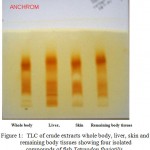 |
Figure 1: TLC of crude extracts whole body, liver, skin and remaining body tissues showing four isolated compounds of fish Tetraodon fluviatilis.
|
Results and Discussions
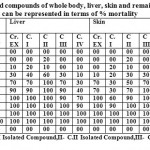 |
Table 1: Effect of crude extracts and isolated compounds of whole body, liver, skin and remaining tissues of Tetraodon fluviatilis on Rice weevil Sitopbilus oryzae by coating method can be represented in terms of % mortality
|
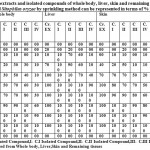 |
Table 2: Effect of crude extracts and isolated compounds of whole body, liver, skin and remaining tissues of Tetraodon fluviatilis on Rice weevil Sitopbilus oryzae by sprinkling method can be represented in terms of % mortality
|
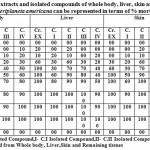 |
Table 3: Effect of crude extracts and isolated compounds of whole body, liver, skin and remaining tissues of Tetraodon fluviatilis on cockroach Periplaneta americana can be represented in terms of % mortality
|
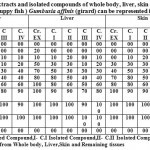 |
Table 4: Effect of crude extracts and isolated compounds of whole body, liver, skin and remaining tissues of Tetraodon fluviatilis on (Guppy fish ) Gumbusia affinis (girard) can be represented in terms of % mortality
|
Effect of Crude Extracts and Isolated Compounds of Tetraodon Fluviatilis on Rice Weevil Sitopbilus Oryzae
Two kinds of experiments were conducted to find the effect of crude extract of whole body, liver, skin and remaining body tissues of Tetraodon fluviatilis on rice weevils Sitopbilus oryzae. Data represented in Table. No1, show the mortality of rice weevils Sitopbilus oryzae after 24 hours of exposure to tissue extracts of fish.
It was evident that compounds isolated from whole body extract shows bioactivity by inducing 100% mortality of the rice weevils after 24 hours exposure. By coating method it was found that, mortality of rice weevils was noted 100% in liver, skin and remaining body tissues extract in 0.7mL concentration. Whereas it was noted 100% in whole body extract in 0.9 mL concentration. From the above data it was evident that the accumulation and concentration of bioactive compounds was found more in liver, skin and other body tissue extracts as compared to whole body tissues of the Tetraodon fluviatilis.
By sprinkling method the effect of crude extract of whole body and remaining body tissues the mortality of rice weevils was noted 100% in 0.9 mL concentration. It was noted 100% mortality in liver at 0.5mL concentration. It was found 100% in skin at 0.6 mL concentration of Tetraodon fluviatilis on rice weevils Sitopbilus oryzae. From the above data it was evident that the liver and skin extract shows more mortality as compared to the whole body extract and other body tissues extract.
The data of effect of isolated compounds (coating method) of whole body extract, Liver, skin and remaining body tissues of Tetraodon fluviatilis on rice weevils Sitopbilus oryzae by coating method are represented in Table No.1
It was evident that compounds isolated from whole body extract shows bioactivity by inducing 100% mortality of the rice weevils Sitopbilus oryzae after 24 hours exposure. The compound –II was found to be more toxic to the rice weevils as compared to compound- I, III and IV. The compounds extracted from liver shows more bioactivity in the form of % mortality in compound II as compared to compound I, III and compound IV. The compounds extracted from skin shows more bioactivity in the form of % mortality in compound III as compared to compound I, II and compound IV .The compounds extracted from remaining body tissues shows more bioactivity in the form of % mortality in compound I and II as III and compound IV of Tetraodon fluviatilis on rice weevils Sitopbilus oryza.
The data of effect of isolated compounds (sprinkling method) of whole body extract, Liver, skin and remaining body tissues of Tetraodon fluviatilis on Rice weevils Sitopbilus oryzae by coating method are represented in Table No.2
It was evident that compounds isolated from whole body extract shows bioactivity by inducing 100% mortality of the rice weevils after 24 hours exposure. The compound –III was found to be more toxic to the rice weevils as compared to compound-I, II, and IV. The compounds extracted from liver shows more bioactivity in the form of % mortality in compound I as compared to compound II, III and compound IV. The compounds extracted from skin shows more bioactivity in the form of % mortality in compound I and II as compared to compound III and compound IV .The compounds extracted from remaining body tissues shows more bioactivity in the form of % mortality in compound II as compared to compound I, III and compound IV of Tetraodon fluviatilis on Rice weevils Sitopbilus oryza.
In control group 100% survival of the weevil was recorded after 24 hours. In the initial stage of the experiment after 30 minutes of exposure, schooling behavior of the weevil was observed. After 30 minutes the weevils were dispersed there after towards the corners of the petridishes. After 1hour the locomotary movement of the weevils was restricted and these weevils could not be moved afterwards and 100% mortality was noticed after 24 hours.
Effect of the Crude Extracts and Isolated Compounds of Tetraodon Fluviatilis on Cockroach Periplaneta Americana
The experiments were conducted to find the effect of crude extract of whole body, liver, skin and other remaining body tissues of Tetraodon fluviatilis on cockroach Periplaneta americana. Data represented in Table. No. 3 shows the mortality of cockroach Periplaneta americana after 24 hours of exposure to different tissue extracts of fish.
It was found that, mortality of cockroach Periplaneta americana was noted 100% in liver extract in 0.5 mL concentration. Whereas it was noted 100% in skin extract in 0.6 mL concentration and in whole body extract and remaining tissues in 0.9mL concentration. From the above data it was evident that the accumulation and concentration of bioactive compounds was found more in liver extracts as compared to whole body tissues, skin and remaining body tissues of the Tetraodon fluviatilis.
It was observed that the compounds isolated from whole body extract shows bioactivity by inducing 100% mortality of the cockroaches after 24 hours exposure. The compound –II and compound IV was found to be more toxic to the cockroaches as compared to compound-I and compound III of Tetraodon fluviatilis on cockroach Periplaneta americana after 24 hours of exposure. The compounds extracted from liver show more bioactivity in the form of % mortality in compound I, II and III as compared to compound IV. The compounds extracted from skin shows more bioactivity in the form of % mortality in compound II as compared to compound I, III and compound IV. The compounds extracted from remaining body tissues shows more bioactivity in the form of % mortality in compound III as compared to compound I, II and compound IV of Tetraodon fluviatilis on cockroach Periplaneta americana after 24 hours of exposure.
It was observed that the cockroaches treated with different extracts and isolated compounds from the whole body, liver, skin and other remaining body tissues showed cleaning behavior at the initial stages of poisoning by rubbing their bodies with their legs or sides of the cages. At the later stages of poisoning cockroaches shows incoordination and convulsion leading to paralysis. Cockroaches were found dead after 24 hours.
Effect of the Crude Extracts and Isolated Compounds of Tetraodon Fluviatilis on Gumbusia Affinis (Girard)
The experiments were conducted to find the effect of crude extract of whole body, liver, skin and other remaining body tissues of Tetraodon fluviatilis on Gumbusia affinis (girard). Data represented in Table. No.4 shows the mortality of Gumbusia affinis (girard) after exposure to different tissue extracts of fish.
It was found that, mortality of Gumbusia affinis (girard) was noted 100% in liver extract in 0.7 mL concentration. Whereas it was noted 100% in skin extract at 0.8 mL concentration. The bioactivity the whole body extracts was found at 0.9mL concentration, whereas the bioactivity was noted in other body tissues at 1.0 mL concentration. From the above data it was found that the accumulation and concentration of bioactive compounds was found more in liver extracts as compared to skin, whole body tissues and remaining body tissues of the Tetraodon fluviatilis.
It was observed that the compounds isolated from whole body extract shows bioactivity by inducing 100% mortality of the Gumbusia affinis after 24 hours exposure. The compound I and compound III shows more and same bioactivity as compared to the compound II and Compound IV of the Tetraodon fluviatilis on Gumbusia affinis after 24 hours of exposure.
The compounds extracted from liver shows same bioactivity in the form of % mortality. Compound I, compound II and compound IV showed more activity whereas compound III shows less bioactivity in compounds extracted from the liver. All the compounds extracted from skin and other body tissues show similar bioactivity of Tetraodon fluciatilis on Gumbusia affinis (girard) after 24 hours of exposure.
After adding the different tissue extracts and the isolated compounds from the whole body, liver, skin and other remaining body tissues of Tetraodon fluviatilis in aquarium containing test fishes (Gumbusia affinis) showed hypersensitivity, an increased respiratory rate by indicating rapid operculum movement. The fishes were become restless and the movement of the body and operculum of fishes becomes lower down and the fishes were settled down at the bottom of the aquarium. At the final stages of intoxication after 24 hours the fishes were dead and found floating on the surface of the aquarium. The area of the brain of dead fishes was found red in color. From the above symptoms it was evident that the toxin found in the crud extract and the isolated compounds of Tetraodon fluviatilis may contains strong toxin which affect the central nervous system of the Gumbusia affinis.
Conclusion
India is endowed with coastal line 8041 Km. and EEZ of 2.02 million sq.Km. However, except exploitation of fisheries resources for food, a scanty attention has been given to identify marine organism as a source of pharmacological or marine drugs from the Arabian Sea. Recently organizations like NIO with the help of DOD have taken up a project to identify the marine organism of Indian coast for exploitation of natural products, which can be use as drugs.
In case of rice weevils, cockroaches and fish Gumbusia affinis (girard), 100 % mortality was noted after 24 hours of exposure to the crude extracts and the isolated compounds. In the present investigation, rice weevils, cockroach, and fish, have been used to test pesticidal activity of the extracts isolated from the fish Tetraodon fluviatilis (fugu fish). The activity was expressed in terms of mortality of rice weevil, cockroach, and fish. Therefore, toxin seems to be present in different parts of the fish Tetraodon fluviatilis (fugu fish). The results of present investigation clearly confirm the pesticidal activity of the crude extract and isolated compounds from tissues of the fish Tetraodon fluviatilis (fugu fish).
References
- Carte B. K. Biochemical Potential of Marine Natural Products. Biosciences April (1996); 271-286
- Halvorson H. O. Aquaculture, Marine sciences and Ocenography; A confluence connection. New Engl. J. Higher Ed. Econ. Dev. 1998;13:28-42.
- Jaiswar A. K and Kulkarni B. G. Conservation of molluscan biodiversity from intertidal area of Mumbai coast. J. Nacton. 2005;17(1):93-105.
- Tilvi S.,Naik C. G. Tandem mass spectrometry of kahalalides : Identification of two new cyclic Depsipeptides, Kahalalide R and S from Elysia grandifolia. J. Mass. Spectrom. 2007;42(1);70-80.
CrossRef - Zodape G. V.,Kulkarni B. G. Occurrence of Anatoxin -A & Homoanatoxin -A in Intertidal crab Leptodius exratus in Mumbai Nariman Point Coast. Bionano Frontier. 2010;3(2):259-264.
- Zodape G. V., Kulkarni B. G., Argekar A. P. Biopotential activity of the extract isolated from intertidal crab Leptodius exaratus Mumbai Nariman point coast”. Pollution Research. 2008;28(3):463-466.
- Zodape G. V., Yamgar R. S.,Kulkarni B. G. Occurrence and charecterisation of Saxitoxin in Intertidal crab Leptodius exratus in Mumbai Nariman Point Coast. Bionano Frontier. 2010;3(2):209-214.
- Zodape G. V. A study on Presence of bioactive compounds In Snail (Achantina fulica) Journal of Applied & Natural Sciences. 2010;2(2):266-268. Print ISSN: 0974-9411 | Online ISSN: 2231-5209.
- Zodape G.V., Berde D. D. Studies on the pharmacological activities of the extracts of Tetraodon oblongus (Fugu fish) from Mumbai coast. Bionano Frontier. 2012;5(2):285-289.
- Zodape G.V. Studies on the Antibacterial and Antifungal activities of bioactive compounds of intertidal crab Atergatis integerrimus (Lamark) of west coast of Mumbai. Bionano frontier. 2014;(2):278-283.
- Zodape G.V. Studies on the pesticidal activities of bioactive compounds of intertidal crab Atergatis integerrimus (Lamark) of west coast of Mumbai. Bionano frontier. Bionano frontier. 2014;( 2):284-289.
- Zodape G. V. Isolation and Characterization of Bioactive Compound from Crab Atergatis integerrimus (Lamarck) Of West Coast of Mumbai (India). Indian Journal of Research in Pharmacy and Biotechnology. 2016;4(2):65-68.
- Vankateshwaran K., Prasad P. Microchemolytic assay P-41-42 in Laboratory manual on advanced Techniques in marine Biotoxinology (Venka K. & Pani Prasad K. Ed) CAS in Fishery science. CIFE Mumbai India. 1997;76.

This work is licensed under a Creative Commons Attribution 4.0 International License.





